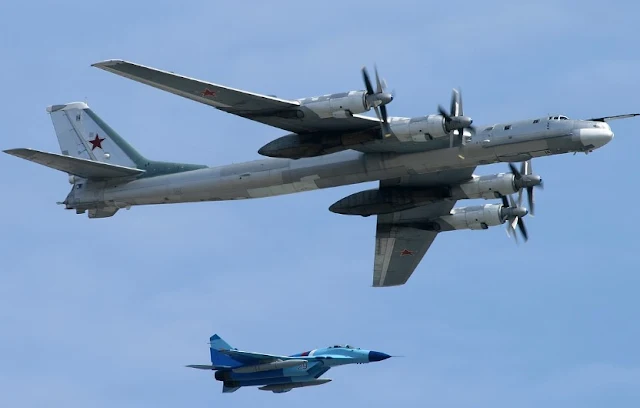 |
| Russian Tu-95 Bombers Fly to ADIZ Escorted by Su-30 Fighter |
International Military - As tensions between the US and China over the Taiwan issue are already high in the region, Russia's defense ministry said on August 23 that it had sent two Tu-95 strategic bombers to patrol neutral waters over the Sea of Japan.
The Russian Tupelov Tu-95 flight was escorted by Su-30 fighter aircraft. The Tu-95 flight took about seven hours.
However, it is suspected that South Korean F-16 jets were escorting Russian Tu-95 aircraft at certain stages of the route. However, this allegation has not been further confirmed by the South Korean military.
The alleged delivery of South Korean F-16s was said to be in response to the Russian Tu-95 flight. South Korea's military said Russian warplanes had violated an air defense zone. And has engaged in unspecified "tactical action". The term 'tactical action' often refers to fighter jets scrambling to repel foreign aircraft.
Air defense identification zones are typically extended beyond a country's borders to allow more time to respond to potentially hostile aircraft. Military jets entering another country's air defense identification zone must notify them in advance.
Read Also: After the 2022 Garuda Shield, the US Conducts Military Exercises with South Korea
In recent years, Russian and Chinese jets have frequently entered South Korea's air defense identification zone, flexing their muscles in the face of increasing competition with the US.
In 2019, a Russian military plane allegedly violated South Korea's national airspace twice near its east coast. According to South Korea, which claims that hundreds of warning shots were fired at the plane by its fighter jets. In line with that, South Korea and the US have been holding joint joint exercises since August 22.
The US and South Korea embark on their biggest joint military exercise as they bolster their defenses against the escalating threat from North Korea. The Ulchi Freedom Shield exercise, which is scheduled for September 1, involves a large number of defense equipment. The various defense equipment involved are planes, warships, tanks, and tens of thousands of personnel.
These exercises simulate joint attacks, front-line weapon and fuel reinforcements, and the elimination of weapons of mass destruction. The exercise will also test drone defense and cyberattacks, simulating some of the warfare seen in Ukraine. In addition, the exercise will involve a military-civilian response to attacks on seaports, airports and critical industrial infrastructure.
South Korea has not disclosed the number of military personnel participating in the latest military drills with the US. However, the country's Defense Ministry said the Ulchi Freedom Shield "normalized" extensive training and field drills between partners.
In recent years, the US and South Korea have canceled some military exercises and restricted others to computer simulations. This was done primarily to increase dialogue with North Korea during Donald Trump's presidency and afterward due to concerns over Covid-19.
Earlier, when the US led by President Donald Trump canceled the drills in early 2018 because he believed the exercises were too expensive and "provocative" for North Korea. Former national security adviser John Bolton denounced the decision as an unwarranted concession to North Korean leader Kim Jong-un.
Meanwhile, Russia and North Korea also want to strengthen their bilateral ties and support each other's geopolitical goals. This support reportedly became so strong that North Korea voluntarily sent thousands of workers to help rebuild the two republics of Donetsk and Luhansk.
Moscow also helped North Korea by joining Beijing in vetoing a UN resolution on May 26 that would have increased sanctions on North Korea in response to a series of ballistic missile launches in the first half of this year.
